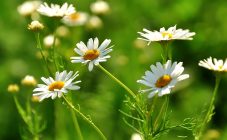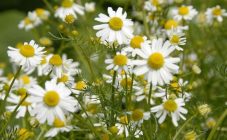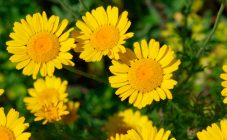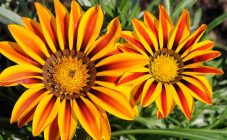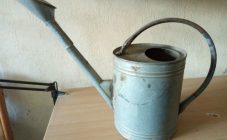Chamomile is a flower that can be kept in almost every garden plot. She is loved for the variety of colors, unpretentious care, decoration of landscape design. She belongs to the Astrov family. Large daisies, depending on the variety, can grow up to 1 meter in height. The stem is strong, deep green, slightly rough. Leaves growing along the length of the stem have a smooth texture, glossy, with dark green veins. The petals are arranged in several rows around the yellow center. The flower itself can reach 15 cm in diameter. The plant pleases the gardener with long flowering. It begins in the first ten days of June, and ends in the last ten days of September.
Chamomile is a plant that has grown exclusively in the wild for a very long time. Only 200 years ago, she interested gardeners, for growing in garden and home plots. From the moment that garden chamomile became widespread among flower growers, breeders began to work on creating new varieties. Today there are a huge number of varieties of this, already decorative, plant. All varieties have a lot in common.
Ornamental varieties have already outstripped their wild relatives in terms of indicators. They also have a larger flower diameter, and they are taller in growth, and various colors, etc. But chamomile cannot be confused with another flower. Its center consists of small tubular flowers, and false-lingual petals are located along the diameter of the central part.
There are many more flowers that belong to the Astrov family. They are somewhat similar to each other. What are the names of flowers that look like large daisies? For example, gerberas. The name itself is large chamomile, meaning Roman. The scientific name of this flower, derived from the Latin matrix, means the uterus.
Types and their characteristics
Many years ago there was a belief that chamomile grew in the place where the star fell. Since the stars are very different in size, color, brightness, etc., plants are also divided into many varieties. Buying garden chamomile at agricultural exhibitions or in specialized stores, a person is lost in a variety of varieties. But you should always know what large chamomile is called, since the maintenance and care may vary slightly.
The most common varieties are:
- Bush chamomile, or daisy;
- North Star;
- Alaska;
- A princess;
- Colored varieties.
Nivyanik is the most common type of shrub giant chamomile, which, in most cases, is grown for sale. It grows up to 1 meter in height. Large daisies, flowers are about 20 cm in diameter (wider than a human hand). It is a tall, sturdy flower that has a regular, flat, deep yellow central part. Compositae perennial. Resistant to low air temperatures. It can multiply once every 4 years by dividing the bush. You can also use the seed propagation method.
The North Star is the most unpretentious variety of large-flowered chamomile. The size of the blossoming buds is about 12 cm. It stretches 35-40 cm in height. The variety loves the sun's rays, so it is undesirable to plant it in the shade. Planting a plant in the garden takes place either in spring or autumn. This species will begin to bloom only in the second year after planting.
Alaska chamomile grows up to 80-90 cm in height. The diameter is 12 cm.If the planting took place in the autumn season, next summer it will delight the gardener with its long flowering. Loves sunny areas protected from drafts and wind. Patient to lack of moisture, frost-resistant.
The Silver Princess is a stunted species that does not grow taller than 35 cm. With this growth, the flowers are 10 cm in diameter. Differs from other varieties in a longer flowering time. It begins in early July and ends with the first frost. Dislikes drought.
Colored varieties are also subdivided into species. Among the multi-colored daisies, the most popular are:
- Persian - blooms throughout the summer. Loves moderate watering, prefers shaded areas. In most cases, it has a delicate pink tint. Large perennial garden chamomiles.
- Red pyrethrum - is distinguished by the large size of beautiful flowers, bright red. Drought tolerant. In severe frosts, it requires shelter.
- Yellow doronicum - the earliest flowering variety. It begins to bloom at the end of March. Flowers are yellow. Undemanding to the soil, does not require special care. The plant blooms for a longer time if it grows in shaded areas. Reaches 70 cm in height. Perennial chamomile.
- Blue Is a relatively young variety. It is characterized by blue and blue color of flowers. It is widely used in medicine, thanks to the essential oil, which is obtained in the process of processing flowers. The size of the flower is not large. The life span is 1 year.
- Orange petal Is a fast growing variety. The flowers are not large, orange in color, the flower petals are narrow and long. Very rarely grown for sale, more often for use in landscaping.
Care advice
Chamomile is recommended to be planted in soil with low acidity. If the soil has a high acid content, it is diluted with slaked soda. The only soil that the plant does not perceive is swampy. If the seed is sown in swampy areas, the development of the flower will slow down, there are high probabilities of a number of diseases, which are almost impossible to get rid of.
Chamomile can bloom in one place for about 6 years, so when planting, you need to determine the distance between the bushes, so that later you do not have to worry and transplant in vain. It is customary to sow chamomile seeds in late spring. The division of the bush takes place mainly in the autumn.
Most varieties are drought tolerant. But for more abundant flowering, it is recommended to water it regularly, without flooding the plants, since an excess of moisture can lead to processes of decay of the root system. Feeding plants with various fertilizers is allowed. In preparation for winter, the plant is pruned. Watering remains the same as it was during flowering. It is recommended to loosen the ground and mulch. In mid-autumn, the soil on which the flower grows can be fertilized with bird or cow droppings.
Diseases common in garden chamomile:
- Rust - characterized by brown spots on the leaves.
- Gray rot - occurs when the soil is highly waterlogged. It is characterized by the presence of a gray coating on the petals and leaves of the plant.
- Fusarium is a lesion of chamomile roots. The plant dries up in a short period.
- Powdery mildew. The initial stage of the disease is manifested by a milky bloom on the leaves of the flower. After a certain period of time, the plaque acquires a brown tint.
Pests dangerous for chamomile:
- Aphid... In the presence of this pest on the stem and leaves of the plant, it is deformed and dies after a short time.
- Star-winged front sight - inhibits the process of plant development. It appears as a result of clogging a bush with weeds.
- Wireworm - lives in the root system of the plant, quickly destroying it.
- Snails and slugs also often attack chamomile.
Chamomile is an unpretentious plant that does not require special attention and care. With the right content, it rarely gets sick, it develops well and quickly. It is available for growing not only for professionals, but also for amateur gardeners. Growing is possible even in the northern part of Russia.




